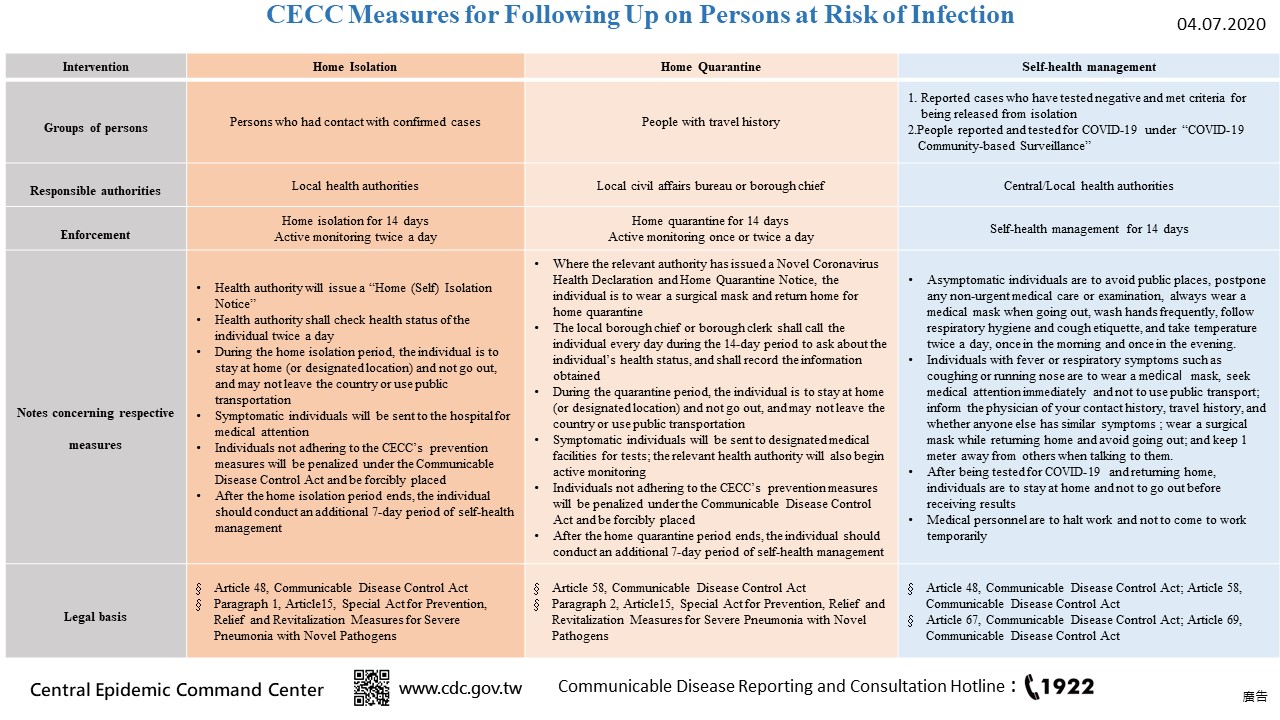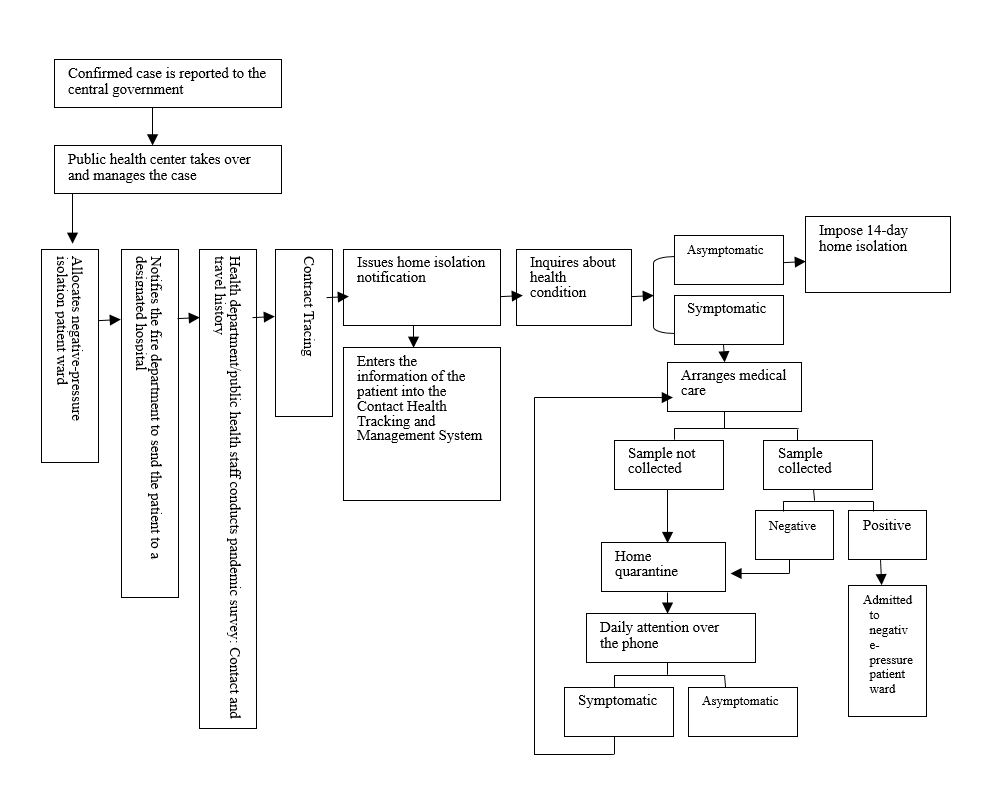Central Government/Local Government/Community-wide Mobilization to Join Forces with Public Health Power in Disease Prevention
After the daunting challenges brought about by diseases such as SARS and the H1N1 flu, communication and interaction among the central government, local governments, and communities have also become more frequent and smoother. This has enhanced the capability of the public health system in Taiwan to prevent spread of infectious diseases and help the people gradually empower themselves in health promotion and in preventive health care.
I. Roles of Local Government Health Departments and Public Health Centers in Disease Prevention
(I) Fundamental public health system provides service and integrates healthcare resources in remote areas
Public health centers (or health service centers) in respective townships are the primary care sites in the community healthcare network. They work together with the central health authorities in promoting fundamental healthcare and services and are responsible for integrating local medical care and healthcare resources in remote areas.
(II) Building a community disease prevention network through the public health system
In order to effectively curb the spread of a disease, besides the various disease prevention measures and the support from the medical care network, the public health system is needed so that a robust community disease prevention network may take shape.
1. Enhancing the health knowledge of people: On a daily basis, health knowledge is communicated in a variety of easy-to-understand ways. During an outbreak, correct disease prevention information is reinforced to block the community-based communication route.
2. Strengthening necessary knowledge and accountability for one’s own health: With a functioning public health system, it helps empower people and communities so that people are willing to cooperate with the government in its policy by enforcing disease prevention at the personal, family, and community levels.
II. Fundamental Public Health System Disease Prevention Strategy
During the current outbreak, health departments are playing a key role in safeguarding against the disease and in keeping the outbreak at bay, reducing damages, and ensuring the health of the local people and communities by working with other units within the county or city.
(I) Forming health department/public health center combat teams
1. Health departments: Integrate intra-departmental resources for purposes of managing the outbreak, integrating and allocating supplies, and investigating and analyzing disease prevention measures and issues, among others.
2. Public health centers/health service centers: Conduct disease monitoring, investigation, and reporting, follow up on and care for those in home isolation, deliver disease prevention supplies, and sell face masks together with community pharmacies starting on February 6.
(II) Strictly keeping the outbreak at bay: Comprehensive containment
The CECC started its reinforced community-based monitoring solution and included suspicious cases in the scope of detection. The local government established the care service center to ensure that people in home quarantine and home isolation are cooperating in disease prevention and that they receive psychological care, medical care assistance, transportation, support in daily life, and hotline services, among others. For confirmed cases reported to the central government, for example, the overall management procedure at public health centers is as follows:
(III) Advance Deployment and Community-wide Mobilization
1. Joining forces with county and city governments in advance deployment: Comprehensive drills covering before, during, and after community-acquired infection are completed to enhance respective disease prevention and control and response capabilities. The drills consist of daily home disease prevention readiness, simple home care, sporadic confirmed cases, infections in a single community, and extensive community spread.
2. Outbreak Drill at Long-term Care Facilities: The drill included initial isolation, reporting, and referral to a hospital for medical attention upon discovery of a suspicious case, environmental cleaning and disinfection, and division of tenants, restrictions over accepting new tenants, and timely adoption of suitable infectious diseases control and prevention measures. It helps reduce the risk of infection and harm done when an outbreak occurs.
3. Push Notification of Health Education and Disease Prevention Guide Applying Information and Telecommunication and Websites: People are provided with open and transparent information so that they can keep track of the condition in their locality. Communication takes place and information is announced continuously in the devoted section set up on the website of the health department at each county/city, as follows:

4. Increased Knowledge and Skills for the People to use in the Outbreak: Community-based healthcare resources such as clinics, pharmacies, laboratory testing facilities, campus healthcare stations, and factory healthcare stations are combined to provide health education and communicate important policies on hospital-acquired infection control, safety, and protection. They are also available in multiple languages so that foreigners living in Taiwan can have access to disease prevention information.
III. Follow-up, Management, and Care Mechanisms for People at Risk of Infection
(I) Care about physical and mental health conditions over the phone and assistance in getting a referral
https://www.cdc.gov.tw/Category/MPage/IRvJdHilZERpzIaEHWKAUg
1. For those in home isolation: Staff of health units under local governments contact subjects twice a day by phone to show concern and understand their condition, and make records of subject conditions.
2. For those in home quarantine: Staff of the civil administration department of the Ministry of the Interior contact those in home quarantine once or twice per day over the phone to show concern and understand their health condition, and make records of subject conditions.
3. For those in home isolation and quarantine that develop respiratory symptoms such as fever and coughing, health units will evaluate and refer them for medical attention.
4. Smart technology-assisted home isolation and home quarantine operations.
(1) Taiwan tracks, manages, and provides care for people subject to home quarantine and home inspection using the electronic fence system aided by mobile phone positioning.
(2) Mobile phones are provided to travelers who enter Taiwan without a Taiwanese phone number for disease prevention, so that officials can immediately intervene and provide assistance and care.
(3) When people who are quarantined leave their homes or turn off their mobile phone, the system will send a warning message to the person in question, as well as the civil affairs department, health department, and local police to determine the person's whereabouts.
(4) Those in home isolation or home quarantine with urgent medical needs who have obtained informed consent from a health department will be referred to a designated telecare healthcare facility and diagnosed and treated through video conferencing.

(II) Promotion of Local Government Home Quarantine and Home Isolation Care Service Program
https://www.cdc.gov.tw/Category/List/acXvUkmTMsiQpB7OfyUGsw
On March 1, the Local Government Home Quarantine and Home Isolation Care Service Program jointly promoted in respective counties and cities to consolidate home quarantine and home isolation measures and to improve the care service network, including target care, medical assistance, transportation arrangements, daily support, and hotline services, among others, to ensure that people have access to the various types of support in their daily life, psychology, and medical care during home quarantine or isolation. Starting in February, counties and cities throughout the nation already introduced their own disease prevention kits to meet the needs of people in home quarantine.

The blessing package offered by the Care Service Center of local governments contains three major items/seven supplies:
1. Nutrients: One large packet of grain powder, one bag of instant rice, and one box of mind-soothing snacks.
2. Health supplements: One box of echinacea health supplements
3. Spiritual supplies: One booklet of Buddhist aphorisms, love and caring card, and safety charm pendant.
- Created:2020-06-05
- Last Updated:2023-04-10
- Data Source:Office of International Cooperation
- Count Views:

